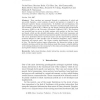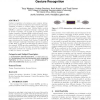1846 search results - page 85 / 370 » Computational Model of Speech Understanding |
BMCBI
2010
13 years 10 months ago
2010
Background: The study of biological systems demands computational support. If targeting a biological problem, the reuse of existing computational models can save time and effort. ...
LRE
2008
13 years 10 months ago
2008
Since emotions are expressed through a combination of verbal and non-verbal channels, a joint analysis of speech and gestures is required to understand expressive human communicati...
FC
2005
Springer
14 years 3 months ago
2005
Springer
We suggest a general paradigm of using large-scale distributed computation to solve difficult problems, but where humans can act as agents and provide candidate solutions. We are e...
ICMI
2003
Springer
14 years 3 months ago
2003
Springer
Gesture recognition is becoming a more common interaction tool in the fields of ubiquitous and wearable computing. Designing a system to perform gesture recognition, however, can...
NOLISP
2005
Springer
14 years 3 months ago
2005
Springer
In current speech technology, linear prediction dominates. The linear vocal tract model is well justified biomechanically, and linear prediction is a simple and well understood si...


